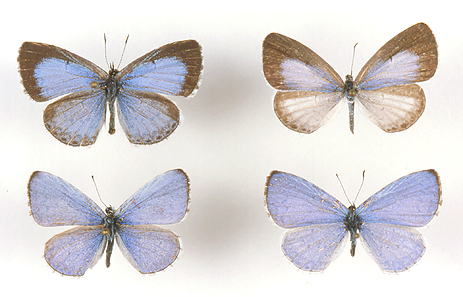Spring Azure Butterflies (Celastrina ladon)
Pricing: Dead (spread, as pictured): $30 each (male or female)
Geographic Range: North America To Panama
View: Top View Sex: Females (top row) & Males (bottom row)
Size: Wingspan: 22 - 35mm
Availability Notes: Inquire about available subspecies. Featured subspecies: LEFT SIDE (male & female) Celastrina ladon ladon, RIGHT SIDE (male & female) Celastrina ladon echo.

Image Copyright 2003
Barbara Strnadova
The Spring Azure is so named because in the northern parts of its range it marks the arrival of warm, spring weather. They range from Alaska and Canada south of the tundra down through most of the U.S.A. (it is absent from coastal Texas, the southern plains and peninsular Florida) and then southward all the way to Panama. In the north, Spring Azures emerge to mate between April and May with another generation emerging later in summer. In the south, there are many broods from January through October. Markedly sexually dimorphic, Celastrina ladon is also seasonally variable. There are also many individual subspecies (two of which are shown) - some of which may actually be separate species. It may be that this "species", Celastrina ladon, is a complex of as many as 6 distinct species, some of which may be threatened by habitat loss. Males can be observed cruising for females all day but are most active between mid-afternoon and dusk. Eggs are laid on flower buds of woody shrubs and occasionally herbs, such as dogwood (Cornus florida), New Jersey tea (Ceanothus americana), meadowsweet (Spiraea salicifolia), and Collinsia. Caterpillars feed on flowers and fruits and are looked out for by ants. The reason is because these caterpillars are equipped with a "honey gland", an organ which emits a sweet liquid relished by the ants. In exchange for this food, the ants protect the caterpillar from predators. The larvae also have a pair of everscible tubercles that can be extended when the caterpillar feels threatened by a potential predator. These are no mock horns but glands that release a chemical that mimics the alarm pheromone of the ants. The ants quickly become frenzied and rally to aid their "comrade." Adult butterflies sip nectar and can be found where ever there are flowers, especially along dirt roads and the edges of deciduous woods but also in old fields and near wooded, freshwater marshes and swamps.